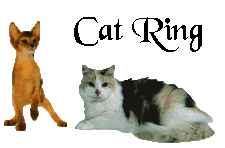
If you liked this java, I found it at
The Omega Factor
 cat people have visited this page since I've fixed this counter.
cat people have visited this page since I've fixed this counter.


Next
Skip Next
Next Five
Previous
Skip Previous
Want to join the ring? Click here for info.
Ears:
Unless you own a Scottish Fold or an American Curl, a
cat's ear send out signals regarding the emotional state of your cat.
Ears that are facing front ward and pointing up means that your cat is relaxed and confident.
Ears that are turned around mean that your cat is angry. Tigers have white spots on their ears which flash when they are angry.
Ears that are flattened against the head means that your cat is very frightened. Frightened cats flatten their ears to protect them from attack.
Ears that seem to flop to the sides mean that your cat is ambivalent about the situation. Your cat doesn't know whether to be afraid or not. So it prepares its ears for the worst.
Also cats will move one ear in response to a sound. And when giving ear mite medication, I found that cats can close their ears really tight.
Eyes:
Cats also give signals with their eyes. Some, like
my cat, Eve , imitate more simian expressions.
But cats who do that are imitating us simians.
Direct stares are intimidating to cats. This is why a submissive cat will not look you directly in the eye, and will even turn away from you.
A cat welcome is to blink slowly and delibrately, then turn away. Even squinting is a sign of welcome. This is why your cat will weave out of reach of your cat loving guest who is giving it a direct stare and hop onto the lap of a cat hater who turned his head away.
The relaxed cat will hold their eye lids at half mast just like a human who is sleepy.
Tail:
The cat's tail is also an indicator of a cat's emotional
state.
A limp relaxed tail means your cat is relaxed and at ease with its surroundings.
When a cat runs towards you with its tail strainght up, the cat is feeling affectionate and kittenish. Kittens run towards their mother with their tails held in the same way.
When the cat holds its tail up and pushes its bottom in your face, this is a greeting from a submissive cat to a more dominant cat.
When a female cat is in heat, she will crouch with her rear end in the air and move her tail to one side.
A moving tail denotes ambivilance, confusion, or anger.
The tip of the tail moves with ambivilance. The cat is feeling just a little uneasy about the situation so the tail moves just a little.
The swinging tail demotes confusion. The cat cannot decide whether to run or fight. The tail moves in sympathy with the cat's undecided mind.
The thrashing tail denotes real anger. This cat is ready to spring.
Body Posture:
Cats will crouch when in fear. They will also run
away low to the ground.
An angry cat will hold its body stiff and straight, tail lashing.
A defensive cat will take up the "halloween posture". Back arched, fur puffed, on tiptoes; this cat will make itself seem larger and more fierce than it really is to fend off an attacker.
A relaxed cat will turn over to expose its belly. This is a sign of trust. This is also another reason your cat may approach a cat hater. The ailurophobe will stiffen, exposing more of his or her midsection. To a cat, this will look just like an invitation to jump on the ailurophobe's lap. Combine that with looking away, and the message might as well be "Jump on me!" written in neon.
This is all the cat signals that I know. If you
have any more, please e-mail me at sweetkittie_2000@yahoo.com

If you liked this java, I found it at
The Omega Factor
 cat people have visited this page since I've fixed this counter.
cat people have visited this page since I've fixed this counter.

